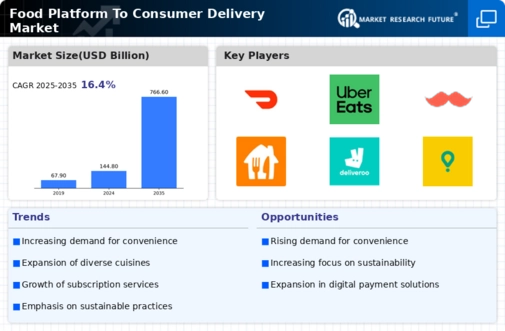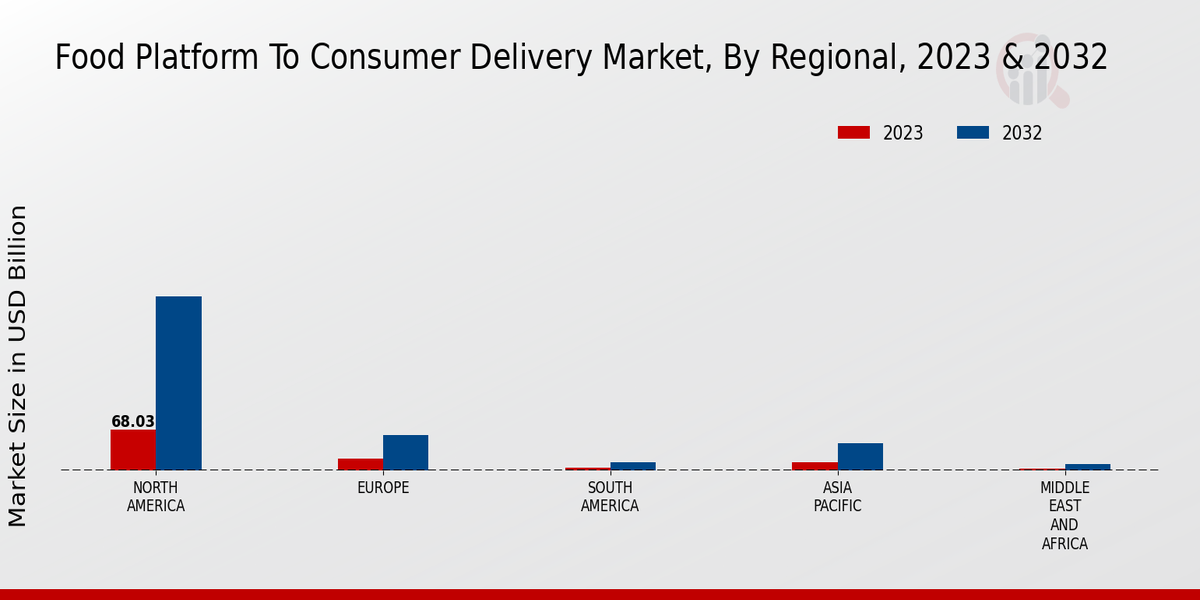Rising Consumer Demand for Convenience
The Global Food Platform To Consumer Delivery Market Industry experiences a surge in consumer demand for convenience, driven by busy lifestyles and the increasing preference for on-demand services. As consumers prioritize time-saving solutions, food delivery platforms are becoming essential. In 2024, the market is valued at approximately 144.8 USD Billion, reflecting the growing inclination towards hassle-free meal options. This trend is likely to continue, as consumers increasingly seek out platforms that offer quick and easy access to a variety of cuisines. The convenience factor is a primary driver, suggesting that the industry will expand significantly in the coming years.
Expansion of Online Food Ordering Platforms
The expansion of online food ordering platforms significantly influences the Global Food Platform To Consumer Delivery Market Industry. With the proliferation of smartphones and internet access, consumers are increasingly turning to digital platforms for their food needs. This shift is evidenced by the rapid growth of various food delivery apps, which cater to diverse culinary preferences. As more restaurants partner with these platforms, the variety of available options continues to increase, attracting a broader customer base. The anticipated compound annual growth rate of 16.36% from 2025 to 2035 indicates a robust future for this segment of the market.
Increased Investment in Food Delivery Startups
Increased investment in food delivery startups is a notable driver of the Global Food Platform To Consumer Delivery Market Industry. Venture capitalists and investors are recognizing the potential for high returns in this rapidly growing sector. As new players enter the market, they introduce innovative business models and services that challenge established companies. This influx of capital not only fuels competition but also fosters innovation, leading to improved customer experiences. The market's growth trajectory suggests that these investments will continue to shape the industry landscape, contributing to its expansion and evolution over the next decade.
Technological Advancements in Delivery Logistics
Technological advancements play a crucial role in shaping the Global Food Platform To Consumer Delivery Market Industry. Innovations such as real-time tracking, automated delivery systems, and advanced routing algorithms enhance operational efficiency and customer satisfaction. These technologies not only streamline the delivery process but also reduce costs, making food delivery more accessible. As the industry evolves, companies that leverage technology effectively are likely to gain a competitive edge. The integration of artificial intelligence and machine learning is expected to further optimize delivery logistics, potentially contributing to the market's projected growth to 766.6 USD Billion by 2035.
Changing Consumer Preferences Towards Healthier Options
Changing consumer preferences towards healthier food options are reshaping the Global Food Platform To Consumer Delivery Market Industry. As awareness of nutrition and wellness increases, consumers are seeking out platforms that offer healthier meal choices. This trend is prompting food delivery services to expand their menus to include organic, plant-based, and nutritious options. Companies that adapt to these preferences are likely to attract health-conscious consumers, thereby enhancing their market position. The growing emphasis on health and wellness is expected to drive demand, further propelling the industry's growth in the coming years.


























Leave a Comment